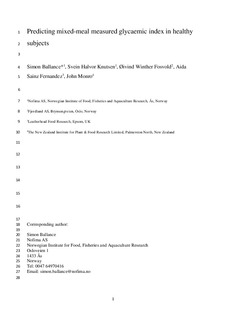| dc.contributor.author | Ballance, Simon | |
| dc.contributor.author | Knutsen, Svein Halvor | |
| dc.contributor.author | Fosvold, Øivind Winther | |
| dc.contributor.author | Fernandez, Alda Sainz | |
| dc.contributor.author | Monro, John | |
| dc.date.accessioned | 2018-10-02T10:32:11Z | |
| dc.date.available | 2018-10-02T10:32:11Z | |
| dc.date.created | 2018-09-17T12:12:29Z | |
| dc.date.issued | 2018 | |
| dc.identifier.issn | 1436-6207 | |
| dc.identifier.uri | http://hdl.handle.net/11250/2565724 | |
| dc.description.abstract | Purpose To determine the influence of meal composition on the glycaemic impact of different carbohydrate staples, and the accuracy of “adjusted calculated meal GI” compared with “measured mixed-meal GI”. Methods In a non-blind randomized crossover trial fasted healthy subjects consumed four dinner-type mixed meals of realistic serving size comprising a carbohydrate staple of either mashed potato, pasta, rice or a glucose drink, combined with fixed portions of boiled carrots, poached salmon and herb sauce. Blood samples collected between 0 and 180 min were analysed for glucose and insulin concentrations. Adjusted calculated meal GI values were determined against a 50 g reference glucose drink, and compared to corresponding measured mixed-meal GIs, supplemented with data from four previous mixed-meal postprandial glycaemic response studies. Results The common carbohydrate staples, and the glucose drink, ingested as part of the salmon mixed meal induced a significantly lower post-prandial relative glycaemic response (RGR) and concurrent higher relative insulin response than the same amount of staple eaten alone. Adjusted calculated mixed-meal GI closely predicted measured mixed-meal GI in healthy subjects for 15 out of 17 mixed meals examined, showing the need to account for effects of fat and protein when predicting measured mixed-meal GI. Further, we showed the validity of using customarily consumed food amounts in mixed-meal postprandial RGR study design. Conclusions Adjusted calculated mixed-meal GI appears a useful model to predict measured mixed-meal GI in healthy subjects and with further development and validation could aid nutrition research and rational design of healthy meals for personalized nutrition and particular consumer groups. | |
| dc.description.abstract | Predicting mixed-meal measured glycaemic index in healthy subjects | |
| dc.language.iso | eng | nb_NO |
| dc.subject | Insulin | |
| dc.subject | Poteter | |
| dc.subject | Potatoes | |
| dc.subject | Blood sugar | |
| dc.title | Predicting mixed-meal measured glycaemic index in healthy subjects | nb_NO |
| dc.title.alternative | Predicting mixed-meal measured glycaemic index in healthy subjects | nb_NO |
| dc.type | Journal article | nb_NO |
| dc.type | Peer reviewed | nb_NO |
| dc.description.version | submittedVersion | |
| dc.source.journal | European Journal of Nutrition | nb_NO |
| dc.identifier.doi | 10.1007/s00394-018-1813-z | |
| dc.identifier.cristin | 1610117 | |
| dc.relation.project | Norges forskningsråd: 262300 | nb_NO |
| dc.relation.project | Norges forskningsråd: 225148 | nb_NO |
| cristin.unitcode | 7543,3,1,0 | |
| cristin.unitname | Mat og helse | |
| cristin.ispublished | true | |
| cristin.fulltext | preprint | |
| cristin.qualitycode | 1 | |
